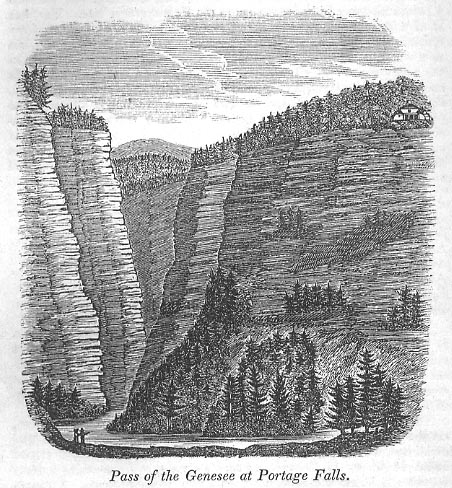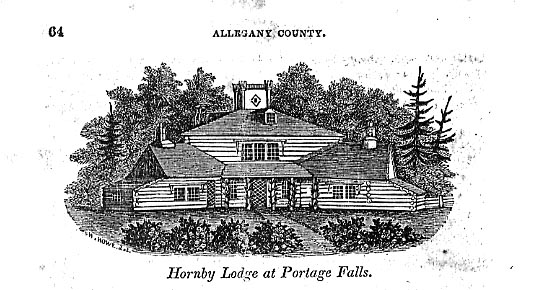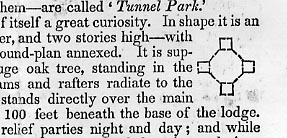John Barber and Henry Howe published the "Historical Collection of the State of New York" which described in detail the counties and communities which existed at that time. This wonderful account of the Portage gorge, Genesee Valley Canal work, and Elisha Johnson's remarkable "Hornby Lodge" is taken from that work. The illustrations are included as they appeared in the book.
"PORTAGE, taken from Nunda in 1827; centrally distant from Albany 247, and from Angelica, north, 18 miles. Pop. 4715. Portageville, on the Genesee river at the head of the rapids, is a flourishing village, containing about sixty or seventy dwellings. The line of the Olean and Rochester canal passes through it. Hunt's Hollow and Oakland are post-offices.
This town is located in an exceedingly interesting region, both from the wild grandeur of its river scenery, and the exhibition of human enterprise and skill in the construction of a tunnel for the canal, through the solid rock, which here bounds the valley of the Genesee. "There are three distinct falls on the river, respectively sixty, ninety, and one hundred and ten feet high, within the space of two miles, each differing in character, and each having peculiar beauties. Although the cascades are highly admirable, they are almost disregarded in the wonder and fear caused by the stupendous, perpendicular walls of the river, rising to four hundred feet in height, and extending along the stream for three miles, with almost as much regularity as if constructed by art. To this great depth the river has worn its bed in the solid rock, in turns as short and graceful, as if winding through the softest meadow."
The middle falls, which are the highest, have been the scene of several narrow escapes, of which, perhaps the following is the most remarkable. Early in the spring of 1827, a boy about fourteen, named Joel Burgess, took a boat into the river above the falls, for the purpose of obtaining a duck which he had shot. In his eagerness to secure the prize, he lost sense of his peril and floated down the stream. On going over the dam, which is situated about twelve rods above the cataract, he was thrown out of the boat, but still held on with both hands. Thus clinging to the frail bark, he was fast hurrying to an awful death, when his feet struck a small projecting rock in the bed of the river. With admirable presence of mind, he let go of the boat and stood fast. His situation was even now full of danger. On each side the water was deep, and the current running with an irresistible force. Chilled and exhausted by the coldness of the element, he was about losing hold of the slippery rock, when those ashore succeeded in throwing him a rope, which he tied around his waist and was dragged exhausted to land. Under these falls, on the northern side, is the "Devil's Oven" a cave fifteen feet in height, and sixty feet deep.

The above is a representation of the gorge, at that point where the river, coming from the south, takes a sudden and abrupt bend to the east. It is situated below the middle and upper falls; both of which are in full sight from near this point. The spectator is supposed to be standing in the valley, and looking eastwardly in the direction of the lower falls, which are about a mile and a half distant. Immediately in front rise massy, perpendicular rocks, to the height of four hundred feet, their summits crowned with gigantic pines and hemlocks, the aged sentinels of an hundred years. In the perspective, the river meanders along its rocky bed, until finally lost to the view behind projecting precipices. Far in the distant horizon is seen the hills of the Cashaqua, and to the right "Hornby Lodge," standing on the verge of the precipice, resembling an ancient chateau; its rude, gothic architecture in keeping with the wildness of the situation. The sketch for the above engraving was taken at the close of the year. Winter had thrown her snowy mantle upon the face of nature. The huge evergreens and naked limbs of the other forest trees were enveloped in their drapery of white; immense icicles hung from the rocks; while the blue of the distant hills, contrasting with it in a scene of indescribable grandeur. Some years since, a party of surveyors cut down an immense pine, standing on the verge of the precipice. It turned one somerset in its descent, and struck its butt perpendicularly upon the rocky bottom of the gorge. Every limb fell to the earth with the shock. It stood for a moment, a tall, limbless trunk, quivered, and fell with a crash.
The tunnel, eleven hundred and eighty feet in length, to which allusion has been made, commences at a point on the southern side of the western termination near the middle falls. The following description of this work, and the "lodge" is from an interesting series of letters entitled "Midsummer Rambles" published in the New York Commercial Advertiser in the summer and autumn of 1840. "The trunk of the tunnel is to be twenty-seven feet wide and twenty feet high. Fortunately, the character of the rock (sandstone) is favorable to the progress of the work. The contractor for this section in Elisha Johnson, Esq., formerly mayor of Rochester, and one of the its most enterprising citizens. Mr. Johnson commenced this vast excavation last year, first running a shaft of 'heading' five and a half feet nearest the roof, and of the entire width required, through the whole length of the tunnel. One of the lateral drifts, for the introduction of air and light from the river brink to the main tunnel, had also been previous completed," the opening to which is seen in the engraving on the rock in front of the "Lodge."
"The entire excavation of this tunnel, including the gallery, shaft, and lateral drifts, will amount to more than twenty-five thousand cubic yards, for which the price paid is four dollars per yard. This, however, will not, by a great amount, cover the entire cost of the tunnel; for since the excavation has been commenced, such is the character of the rock - thrown together apparently by nature in loose masses and blocks - that it now appears that the entire roof and sides of the tunnel will require arching with solid mason work. Indeed, temporary arches of wood have been found necessary during the progress of almost ever successive yard of the work. It is by far the greatest undertaking of the kind that has been attempted in our country.

"Perceiving, at the outset, that his contract would require a long time for its completion, Mr. Johnson, whose daily presence was necessary, wisely determined to surround himself by his family. He accordingly prepared 'a lodge' for them in the 'wilderness'. The site selected is wild and picturesque in a high degree. It stands upon a small plain or table, upon the highest verge of the precipitous bank of the river so often adverted to, a few yards only from the edge, which juts out, and almost impends over the abyss, threatening to descend and overwhelm all that may be below. The site of the building is near the southwestern entrance of the tunnel. (see footnote by Howe) Facing that direction, a full view is presented of the chasm of the river, and the upper and middle falls; the roar of which is incessant, and the ascending clouds of vapor of which form objects of every-varying and incessant interest and beauty. " Hornby Lodge' is the name of Mr. Johnson's castle, and the grounds around it - purposely kept as wild as nature herself has made them - are called 'Tunnel Park.'
The
house, or lodge, is of itself a great curiosity. In shape it is
an octagon, sixty feet in diameter, and two stories high - with
wings - according to the ground-plan annexed. It is supported
by the trunk of a huge oak tree, standing in the center, from
which the beams and rafters radiate to the outward circumference.
It stands directly over the main tunnel,
the roof of which is 100 feet beneath the base of the lodge. The
work is prosecuted by relief parties night and day; and while
the miners were at work directly beneath the lodge, the explosions
of the powder used in blasting were both heard and felt by the
family, essentially disturbing their slumber at night. The ornaments
of the lodge, over the doors and windows, and much of the furniture,
are truly Gothic, being formed from the crookedest limbs of trees
that could be found. On the whole, it is a most picturesque establishment,
standing alone in its rustic beauty, and looking out fearfully
upon the confined deep. I was a partaker of Mr. Johnson's hospitality
for one night. It was a beautiful moonlight night; and both by
day and night I enjoyed the scene to the full."
directly over the main tunnel,
the roof of which is 100 feet beneath the base of the lodge. The
work is prosecuted by relief parties night and day; and while
the miners were at work directly beneath the lodge, the explosions
of the powder used in blasting were both heard and felt by the
family, essentially disturbing their slumber at night. The ornaments
of the lodge, over the doors and windows, and much of the furniture,
are truly Gothic, being formed from the crookedest limbs of trees
that could be found. On the whole, it is a most picturesque establishment,
standing alone in its rustic beauty, and looking out fearfully
upon the confined deep. I was a partaker of Mr. Johnson's hospitality
for one night. It was a beautiful moonlight night; and both by
day and night I enjoyed the scene to the full."
To the foregoing description, we would add that the building presents a similar appearance from every direction. There is between each pair of wings a door which opens into an octagonal saloon, occupying the whole of the basement, excepting the wings. This saloon is in true "log cabin" style. The trunk of the huge oak, previously alluded to, with its shaggy bark covering, rises from the floor in the centre of the room as a pillar to support the ceiling. The furniture, chairs, sofas, etc, in this apartment are formed of the rough limbs of the forest. The wings are divided into rooms of convenient size answering the respective purposes of parlor, library, office, conservatory, kitchen, etc.ect. The structure approaches to the Swiss Gothic style, and its peculiar and novel feature is, that while the lower story is an octagon, the upper is a quadrilateral, diamonding with the base.
We will close our account of this region by a description of the lower falls, taken from the "Rambles." "The water at the lower falls rushes around an immense rock in its descent, close under the southeastern bank. Fortunately for visitors, as yet the scene has been thus far permitted by man to remain in a state of nature. It is therefore as wild and romantic as can be desired. A dark screen of evergreen, hanging over the cataract so near and thick as to render it unsafe to push through it, partially hides the descending torrent of foam, which dots after its final plunge the river to a considerable distance with cream-like ornaments. Partly detached from the main wall which confines the river to its narrow bed, a huge rock partially conceals the fall, tapering upward like a sugar-loaf, and crested with evergreens. On the opposite, or western side, the top of the rock around which the waters hurry in their maddened wrath, is level as the house-floor, and large enough for a company of
to
perform their martial exercises upon. Midway from the top, the
sugar-loaf is united to the main buttress. The depth of this fall
is 96 feet."
* Having formerly been some years engaged on public works, we were naturally interest in the construction at this place. Much credit is due to Mr. Edward A. Stillman, a young man of 22, who is the resident instrumental engineer. His lines have been run with uncommon success as compared with similar works in Europe.-H.H.
Source:
Barber and Howe, "Historical Collections of the State
of New York containing A General Collection of the most Interesting
Facts, Traditions Biographcial &c relating to its History
and Antiquities, with Geographic Descriptions of Every Township
in the State". 1842 Edition pp 61-65
Also see our Glimpse of the Genesee Valley Canal. and Glimpse of Hornby Lodge